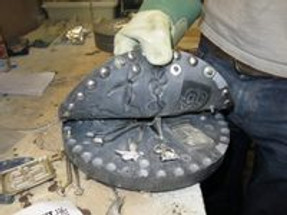Posted by The Alchemy Editorial Team on 2nd Aug 2016
The Process of Alchemy (Part 3 – Moulding and Casting)
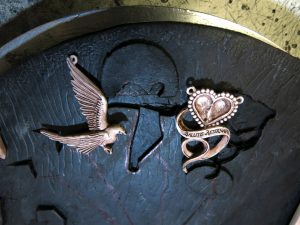 Finished cast resin models are sent down from the workshop to the mold
room in the production department. It is here that the master mold
maker employs his extensive experience to assess each piece and
determine the most effective of his long-evolved techniques to develop
each production mold.
Finished cast resin models are sent down from the workshop to the mold
room in the production department. It is here that the master mold
maker employs his extensive experience to assess each piece and
determine the most effective of his long-evolved techniques to develop
each production mold.
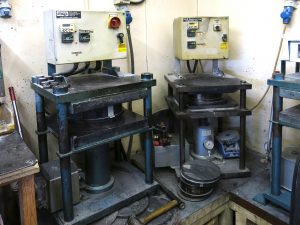 Casting molds are made from discs of uncured rubber. To begin, each
model has to have its approximate shape hand-cut and modeled into the
surfaces of the rubber, i.e., pre-formed. Once completed, the rubber
‘sandwich’, separated by a parting agent, is encased in a heavy, steel
‘can’, able to withstand the great pressures and heat of the next part
of the process. These loaded mold cans then go into one of our mold
presses to be slowly heated and compressed over a number of hours, where
the rubber semi-liquidizes to become perfectly formed around the
models, and then sets and is vulcanized, or cured. The process
permanently changes the property of the rubber into something similar to
that of a car tire, with the ability to withstand casting temperatures
of up to 300°C.
Casting molds are made from discs of uncured rubber. To begin, each
model has to have its approximate shape hand-cut and modeled into the
surfaces of the rubber, i.e., pre-formed. Once completed, the rubber
‘sandwich’, separated by a parting agent, is encased in a heavy, steel
‘can’, able to withstand the great pressures and heat of the next part
of the process. These loaded mold cans then go into one of our mold
presses to be slowly heated and compressed over a number of hours, where
the rubber semi-liquidizes to become perfectly formed around the
models, and then sets and is vulcanized, or cured. The process
permanently changes the property of the rubber into something similar to
that of a car tire, with the ability to withstand casting temperatures
of up to 300°C.
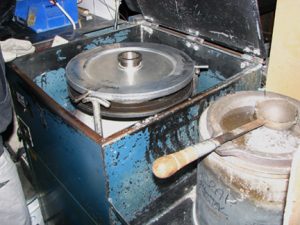 When the cured mold has cooled and is taken out of its can, it then
needs to be expertly cut, by hand, to allow a good flow of the molten
metal into each mold cavity.
When the cured mold has cooled and is taken out of its can, it then
needs to be expertly cut, by hand, to allow a good flow of the molten
metal into each mold cavity.
When tested and ready for casting, a machine is set-up for that particular mold, with the spin speed and pressure, etc, having to be tailored for each; the mold is then loaded onto the casting machine’s turntable and the machine switched on. Casting is a skilled and specialized job relying on great experience and judgement, with every mold and component having their own unique characteristics and idiosyncrasies.
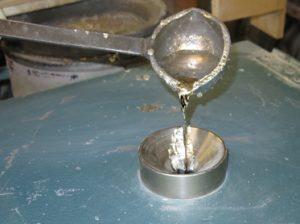 The English Pewter used to make all Alchemy products is far from being
easy to cast in, being free of lead, nickel and all other additives
which would seriously increase the flow of the molten metal. However, in
previous times as well as currently in lower grade products, toxic
additives such as lead, cadmium and bismuth are included in the alloys
making castings much easier and cheaper to produce. English Pewter,
however, is pure and made from only three minerals; around 92% tin, 7%
antimony and 1% copper. Heated-up to, typically, 290° C, the metal is
skilfully and swiftly ladled from the melting pot straight into the
spinning mold, which centrifugally forces the molten metal into each
cavity. In around 1-2 minutes, the metal will be set, the mold ready to
take out and the raw castings removed.
The English Pewter used to make all Alchemy products is far from being
easy to cast in, being free of lead, nickel and all other additives
which would seriously increase the flow of the molten metal. However, in
previous times as well as currently in lower grade products, toxic
additives such as lead, cadmium and bismuth are included in the alloys
making castings much easier and cheaper to produce. English Pewter,
however, is pure and made from only three minerals; around 92% tin, 7%
antimony and 1% copper. Heated-up to, typically, 290° C, the metal is
skilfully and swiftly ladled from the melting pot straight into the
spinning mold, which centrifugally forces the molten metal into each
cavity. In around 1-2 minutes, the metal will be set, the mold ready to
take out and the raw castings removed.
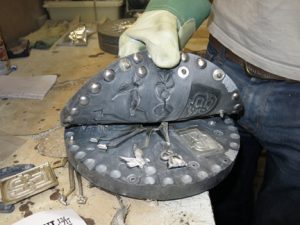 Each one of these castings is the just beginning, becoming the basic
component of an Alchemy England piece. A small batch of similar castings
is produced at a time, taking advantage of the caster’s finely-tuned
settings and the gradually optimised operating temperature of the mold.
Each one of these castings is the just beginning, becoming the basic
component of an Alchemy England piece. A small batch of similar castings
is produced at a time, taking advantage of the caster’s finely-tuned
settings and the gradually optimised operating temperature of the mold.
Next month, the final Part, 4 will explain our process of Finishing and Assembly.

